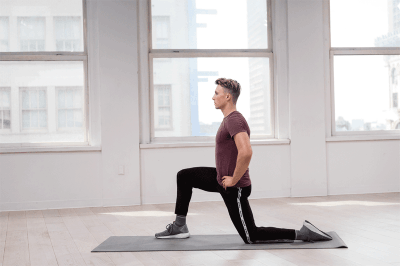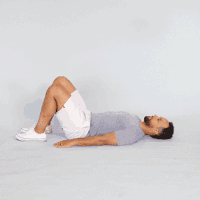Hip pain can be a debilitating issue that interferes with everyday activities and quality of life. Whether it stems from an injury, arthritis, or other underlying conditions, finding effective relief is essential. In this guide, we will explore the role of physical therapy in managing and alleviating hip pain. Discover how tailored exercises and therapies can help you regain mobility, reduce discomfort, and regain control over your hip health.
Contents
Understanding the Causes of Hip Pain
Hip pain can stem from various sources, and comprehending its underlying causes is crucial for effective treatment. Let’s delve into the diverse factors that can contribute to hip pain:
- Osteoarthritis: Firstly, this degenerative joint disease involves the breakdown of the hip’s cartilage over time, leading to pain, stiffness, and reduced mobility. Aging and wear and tear are common causes.
- Hip Fractures: Secondly, accidents, falls, or traumatic injuries can result in hip fractures, causing intense pain and requiring immediate medical attention.
- Bursitis: Thirdly, inflammation of the fluid-filled sacs (bursae) around the hip joint can lead to bursitis. Overuse, repetitive motions, or trauma can cause this condition, resulting in pain and discomfort.
- Tendinitis: Fourthly, irritation or inflammation of the tendons around the hip can lead to tendinitis, often caused by overuse or muscle imbalances.
- Muscle Strains: Moreover, overexertion or sudden movements can cause strains in the muscles supporting the hip joint, resulting in pain and limited movement.
- Labral Tears: Additionally, tears in the cartilage lining the hip socket (labrum) can cause pain, often associated with activities that involve twisting or pivoting.
- Hip Impingement: Also known as Femoroacetabular Impingement (FAI), this condition occurs when there is abnormal contact between the hip’s ball and socket, leading to pain and potential damage to the joint.
- Rheumatoid Arthritis: An autoimmune disorder, rheumatoid arthritis can affect the hip joint, leading to inflammation, pain, and joint damage.
- Nerve Compression: Conditions like sciatica or pinched nerves in the lower back can radiate pain to the hip region.
- Referred Pain: Sometimes, pain originating from other areas of the body, such as the spine or pelvis, can manifest as hip pain, making diagnosis challenging.
- Infections: Rarely, infections in the hip joint can cause severe pain and require immediate medical attention.
- Overuse and Repetitive Stress: Engaging in activities that place excessive stress on the hip joint, such as long-distance running, can lead to overuse injuries and hip pain.
Understanding the specific cause of your hip pain is crucial for developing an effective treatment plan. Consequently, if you’re experiencing persistent hip discomfort, seeking professional evaluation is recommended to identify the root cause and initiate appropriate therapies for relief.
When You Seek Medical Attention?
 Knowing when to seek medical attention for hip pain is essential for timely diagnosis and treatment. Here are some key points to consider:
Knowing when to seek medical attention for hip pain is essential for timely diagnosis and treatment. Here are some key points to consider:
- Severe Pain: If you experience intense or excruciating pain in your hip, especially after an injury or fall, seek immediate medical attention.
- Inability to Bear Weight: If you find it difficult or impossible to put weight on your affected hip or leg, consult a healthcare professional promptly.
- Signs of Infection: If your hip pain is accompanied by signs of infection, such as redness, warmth, swelling, or fever, contact a healthcare provider.
- Sudden Swelling: Unexplained and sudden swelling around the hip joint should not be ignored and warrants medical evaluation.
- Limited Range of Motion: If your hip pain restricts your ability to move your leg or hip joint normally, it’s important to get a medical assessment.
- Persistent Pain: Chronic or long-lasting hip pain that doesn’t improve with rest or over-the-counter pain medication should be evaluated by a healthcare professional.
- Recent Trauma: If your hip pain is the result of a recent accident, fall, or trauma, it’s crucial to get a medical examination to rule out fractures or other injuries.
- Worsening Symptoms: If your hip pain is progressively worsening, or if you notice new symptoms like numbness or tingling, seek medical advice.
- Underlying Health Conditions: If you have underlying health conditions like rheumatoid arthritis or osteoarthritis and experience hip pain, consult your healthcare provider for appropriate management.
- Unexplained Hip Pain: When you’re unsure of the cause of your hip pain, it’s wise to consult a medical professional for a thorough evaluation and diagnosis.
Remember, timely medical attention can help diagnose the underlying cause of your hip pain and prevent potential complications. If you’re in doubt or experiencing severe discomfort, don’t hesitate to reach out to a healthcare provider.
Treatment For Hip Pain

- Rest and Activity Modification: For mild hip pain, rest and avoiding activities that exacerbate the pain can be effective. It’s important to strike a balance between rest and gentle movement to prevent stiffness.
- Physical Therapy: Physical therapists can develop tailored exercise programs to strengthen hip muscles, improve flexibility, and enhance joint stability. Physical therapy can be particularly beneficial for conditions like hip osteoarthritis.
- Medications: Over-the-counter pain relievers like acetaminophen or nonsteroidal anti-inflammatory drugs (NSAIDs) can help reduce pain and inflammation. Prescription medications may be necessary for more severe pain.
- Corticosteroid Injections: In cases of hip inflammation or bursitis, corticosteroid injections into the hip joint can provide targeted relief from pain and swelling.
- Physical Modalities: Heat and cold therapy, ultrasound, or electrical stimulation techniques can help alleviate hip pain and improve circulation.
- Hip Bracing or Supports: Some conditions may benefit from wearing hip braces or supports to stabilize the joint and reduce pain.
- Activity Modification: Adjusting your daily activities and using assistive devices like crutches or canes can help reduce stress on the hip joint.
- Weight Management: Maintaining a healthy weight is crucial, as excess weight can put additional strain on the hip joints. Weight loss through diet and exercise can alleviate hip pain in some cases.
- Surgery: In severe cases, when conservative treatments are ineffective, surgical intervention may be necessary. Surgical options can range from arthroscopy to repair or remove damaged tissue to total hip replacement for advanced osteoarthritis.
- Lifestyle Modifications: Adopting a healthy lifestyle with regular exercise, proper nutrition, and stress management can contribute to overall hip joint health.
Exercises for Hip Pain
Exercise for hip pain can be an effective way to alleviate discomfort and improve hip joint mobility and strength. Here are some exercises commonly recommended by physical therapists for hip pain relief:
Hip Flexor Stretch

- Kneel on one knee with the other foot in front, forming a 90-degree angle.
- Gently push your hips forward until you feel a stretch in the front of the hip.
- Hold for 20-30 seconds and switch sides.
- Repeat 2-3 times on each side.
Piriformis Stretch

- Sit on the floor with one leg straight and the other leg bent so that your foot is resting on the opposite side of the straight leg.
- Gently pull the bent knee toward your chest until you feel a stretch in your buttocks.
- Hold for 20-30 seconds and switch sides.
- Repeat 2-3 times on each side.
Hip Abductor Strengthening
- Lie on your side with your legs straight.
- Lift the top leg as high as you can without moving your hips.
- Lower the leg back down.
- Do 3 sets of 10-15 repetitions on each side.
Hip Adductor Strengthening
- Sit with your knees bent and a ball or pillow between your knees.
- Squeeze your knees together against the resistance of the ball or pillow.
- Hold for 5 seconds and release.
- Do 3 sets of 10-15 repetitions.
Bridges
- Lie on your back with your knees bent and feet flat on the floor.
- Lift your hips off the ground, keeping your feet and shoulders on the floor.
- Hold for a few seconds, then lower your hips back down.
- Do 3 sets of 10-15 repetitions.
Clamshells

- Lie on your side with your legs bent at a 90-degree angle.
- Keeping your feet touching, lift your top knee as high as you can without moving your pelvis.
- Lower your knee back down.
- Do 3 sets of 10-15 repetitions on each side.
Standing Hip Flexor Stretch
- Stand up straight.
- Take a step back with one foot and bend both knees into a lunge.
- Feel a stretch in the front of your hip on the back leg.
- Hold for 20-30 seconds and switch sides.
- Repeat 2-3 times on each side.
Quadriceps Stretch
- Stand up straight.
- Bend one knee and bring your heel toward your buttocks.
- Grab your ankle and gently pull your heel closer to your buttocks.
- Hold for 20-30 seconds and switch sides.
- Repeat 2-3 times on each side.
Leg Swings
- Hold onto a stable surface for support.
- Swing one leg forward and backward like a pendulum.
- Do this for 1-2 minutes on each leg.
Always consult with a healthcare provider or physical therapist before starting any new exercise routine, especially if you have hip pain or a hip condition. They can provide personalized guidance and ensure that the exercises are safe and appropriate for your specific situation.
Physical Therapy For Hip Pain
Physical therapy, undoubtedly, is an effective approach for managing and alleviating hip pain. Moreover, it involves targeted exercises, stretches, and manual techniques designed to improve hip joint function, strengthen surrounding muscles, and reduce pain. Here are key aspects of physical therapy for hip pain:
Comprehensive Assessment: First and foremost, a physical therapist will conduct a thorough evaluation to assess the specific cause and severity of your hip pain. This assessment helps tailor a personalized treatment plan.
Pain Management: Subsequently, physical therapists employ various modalities to manage pain, including heat, cold therapy, ultrasound, or electrical stimulation. These techniques can help reduce pain and inflammation.
Strengthening Exercises: Weak hip muscles can contribute to pain and instability. Therefore, physical therapists prescribe exercises to target specific muscle groups, such as the hip abductors, adductors, flexors, and extensors. Strengthening these muscles can enhance joint stability and relieve pain.
Range of Motion (ROM) Exercises: Furthermore, restricted hip joint mobility is common in conditions like hip osteoarthritis. Thus, physical therapists use specific ROM exercises to improve joint flexibility and function.
Stretching Routines: Notably, stretching exercises are essential for maintaining hip joint flexibility. Consequently, stretching can alleviate muscle tightness and reduce pain associated with conditions like hip bursitis or tendinitis.
Manual Therapy: Additionally, hands-on techniques like joint mobilization or soft tissue massage can help improve hip joint mobility and alleviate pain. Physical therapists use these methods to address muscle knots, trigger points, and joint restrictions.
Gait Training: Walking or running with an abnormal gait can exacerbate hip pain. Consequently, therapists provide guidance on proper walking and running techniques to minimize strain on the hip joint.
Balance and Proprioception Training: Importantly, balance exercises are crucial for hip pain management, especially in older adults. Therefore, improved balance reduces the risk of falls and subsequent hip injuries.
Posture and Body Mechanics Education: Poor posture and incorrect body mechanics can contribute to hip pain. Thus, physical therapists educate patients on maintaining proper posture and body alignment during daily activities to prevent pain exacerbation.
Home Exercise Programs: In addition, physical therapists design home exercise programs to encourage patients to continue their rehabilitation outside of clinic sessions. Consistency in performing exercises is key to long-term hip pain relief.
Patient Education: Furthermore, understanding the underlying cause of hip pain and how to manage it is essential. Consequently, physical therapists educate patients about their condition, provide strategies for pain relief, and offer guidance on preventing future issues.
Assistive Devices: Lastly, in some cases, therapists may recommend assistive devices such as canes or crutches to offload the hip joint during walking and reduce pain.
Physical therapy for hip pain aims to improve mobility, reduce discomfort, and enhance the overall quality of life. Moreover, the duration and frequency of therapy sessions will vary depending on the individual’s condition and response to treatment. Consequently, it’s important to follow the therapist’s recommendations for the best results.
Conclusion
In conclusion, hip pain can be effectively managed through a combination of stretching, strengthening, and mobility exercises. These exercises aim to alleviate discomfort, improve flexibility, and enhance the strength of the hip muscles. Remember to consult with a healthcare provider or physical therapist before beginning any exercise program, and tailor your routine to your specific needs and condition. Consistency in performing these exercises, along with proper guidance, can contribute to a more comfortable and functional hip joint.
If you’re experiencing Hip pain, physiotherapy for hip pain at PhysioMantra can help: Book an online physical therapy session.



